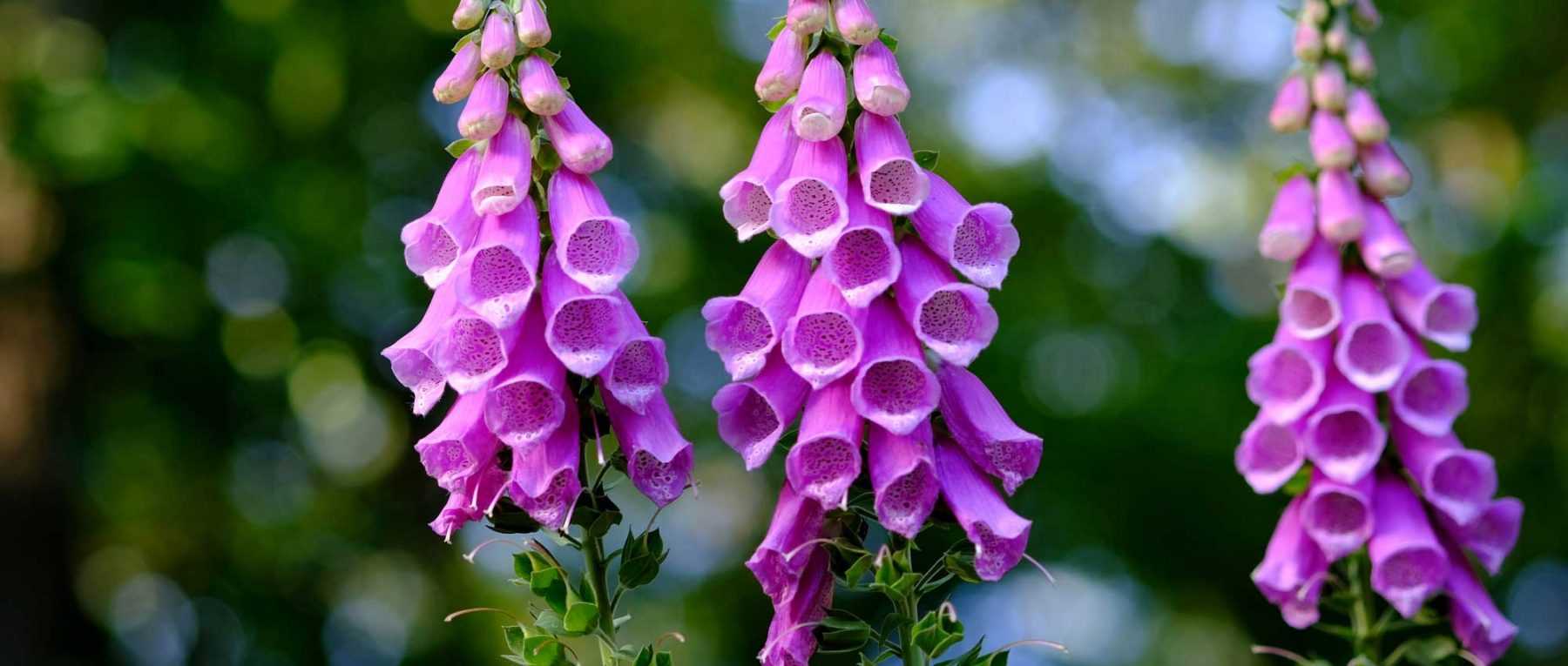
Foxgloves: Sowing, Planting and Care
Contents
Foxgloves in a nutshell
- Foxgloves impress us in summer with their tall, upright flower spikes!
- Their blooms come in soft hues: pink, purple, yellow, white, chocolate, apricot…
- They add structure and vertical interest to flower beds
- These are perfect plants for naturalistic borders or cottage gardens
- They require little maintenance and tend to self-seed readily
Our Expert's Word
Foxgloves are biennial or perennial plants that bloom in summer. They produce tall, upright flower spikes, adding structure and height to the garden. They are cherished for their striking appearance, luminous blooms, and natural charm! The most well-known is the common foxglove, Digitalis purpurea, but there are many other species and varieties to discover. From the elegant white blooms of the white foxglove (Digitalis purpurea ‘Alba’), the ochre-brown tones of the woolly foxglove, to the bright flowering of the yellow foxglove, the choice is vast—and these plants never cease to amaze with their varied hues and impeccable form! Some varieties can look strikingly different, like the fiery bell-shaped blooms of Digitalis obscura.
Foxgloves thrive in partial shade or sun, in light, well-drained, humus-rich soil. They dislike waterlogged conditions as well as overly dry ground. They require minimal maintenance—just occasional watering during droughts, staking if exposed to strong winds, and deadheading spent flowers if desired. They are fully hardy. Though they may not live long in the garden, foxgloves make up for it by self-seeding abundantly.
Botany
Botanical data
- Latin name Digitalis sp.
- Family Plantaginaceae
- Common name Foxglove, Lady's Glove, Fairy Gloves...
- Flowering From June to August - September
- Height Up to 2 metres tall
- Exposure Partial shade or sun
- Soil type Well-drained, humus-rich, light
- Hardiness Depending on variety, between -15 and -30°C.
The foxgloves comprise between 20 and 25 species of biennial or short-lived perennial plants. They are completely hardy. They originate from Europe, Asia and North Africa. The most well-known is the Common Foxglove, Digitalis purpurea, which grows wild in much of France, except in the Mediterranean region. It can be found at woodland edges, along paths, in clearings or on wasteland. In France, you may also encounter Digitalis grandiflora and Digitalis lutea in the wild.
Foxgloves belong to the Plantaginaceae family, but were previously classified under Scrophulariaceae. The Plantaginaceae family includes many plants, often herbaceous, such as plantain, penstemons, veronicas or snapdragons. Foxgloves actually look very similar to penstemon flowers!
The name foxglove comes from the Latin digitus, meaning “finger”, because you can insert a finger into the flower as if it were a glove. This is also why it’s sometimes nicknamed “Lady’s Glove”, “Fairy Gloves” or “Witch’s Gloves”.
Foxglove is a tall, very upright plant that adds vertical interest to the garden. It’s quite an impressive plant: it has a natural appearance and blends in easily, but it’s immediately noticeable thanks to its height, imposing shape and luminosity. The flower spikes can reach up to two metres tall in the case of the Common Foxglove! However, some shorter species don’t exceed 60 cm (Digitalis lutea, Digitalis dubia, Digitalis parviflora…). Foxglove produces a large, very straight flower stem, unbranched. It’s sturdy, robust, hollow and hairy. Foxgloves are often hairy plants: their stems, flowers, seed capsules and the undersides of leaves usually bear a fine down of white hairs.
Foxglove produces a rosette of leaves in its first year and only flowers the following year. It will either die after flowering (while self-seeding) or live for a few more years. If you’re looking for a perennial foxglove, choose for example Digitalis mertonensis or Digitalis ‘Glory of Roundway’.
Foxglove flowers in June-July, and sometimes until September. You’ll need to wait until the second year to see it flower, as in the first year it only produces a rosette of leaves.
Foxgloves bear long, upright flower spikes, composed of numerous flowers. These are densely grouped, all on one side of the stem, and they bloom from the bottom upwards. Those at the top of the spike are therefore still closed when those at the bottom are in full bloom. Digitalis lutea has a very delicate appearance: its clusters are narrow and long, made up of small, slender flowers.
The flowers are tubular or take the form of elongated bells, facing downwards. They are composed of five fused petals forming a flared tube, surrounded by five sepals. At the end, the corolla opens into two lips, not always very distinct. The upper lip forms two lobes, and the lower one three lobes, sometimes very developed. Inside the corolla tube are four stamens. It’s quite common for the flowers to be hairy.
The Common Foxglove bears large flowers, measuring between four and five centimetres long. They are much smaller in other varieties. In Digitalis parviflora, for example, they don’t exceed two centimetres in length.
Although the most well-known is the purple foxglove, foxgloves can come in other colours. There are beautiful variations in shades, with reds, mauves and light pinks, but also yellow-flowered foxgloves, or sometimes pure white, making the plant very elegant! (as in ‘Snow Thimble’). Other times, they take on a chocolate brown hue, as in Digitalis parviflora. The colours are quite warm, but often soft. Digitalis obscura stands out from other varieties with its bright orange-red flowers. Apart from this particular foxglove, for more vibrant blooms, you should look to digiplexis, plants resulting from crosses between foxgloves and Isoplexis!
The inside of foxglove flowers is usually marked with darker patterns: it may be spotted with small dots or random shapes, or veined. The contrast is quite exceptional in the Digitalis purpurea ‘Pam’s Choice’, making the whole flower spike almost hypnotic! As for Digitalis purpurea, it bears flowers of a fairly light purple-pink, contrasted by dark purple spots inside the corolla.
Foxglove is a nectar-rich plant: it’s pollinated by insects, particularly bumblebees and bees. The lower lip of the corolla serves as a landing platform for insects coming to feed on the nectar at the base of the flower.


The different blooms of foxgloves! Digitalis purpurea (photo H. Zell), Digitalis lanata (photo Katya), Digitalis_grandiflora (photo Orchi) and Digitalis obscura (photo Peganum)
Foxglove leaves are entire and elongated, oval, undivided. Depending on the variety, they measure between 5 and 25 centimetres in length. They are sometimes toothed along the edge of the blade. They are dark green in colour and often downy on the underside. The veins are very pronounced, giving the leaves a quilted appearance. Some of the leaves form a rosette at the base of the flower spike, others are attached to the stem, arranged alternately (one after the other). The basal leaves are large and long-stalked. The higher up the flower stem you go, the smaller the leaves become, almost stalkless (very short petiole), and they become sparser, less dense. The leaves of Digitalis obscura are very narrow, almost linear.
The fruits are hairy capsules (covered with fine hairs), which open when ripe, releasing a multitude of tiny seeds. They are dispersed by wind or animals. Foxgloves tend to self-seed readily.
Foxgloves have been crossed with isoplexis (Isoplexis canariensis) – a very close plant, sometimes classified among foxgloves – to produce Digiplexis. These hybrids bear upright flower spikes like foxgloves, but their flowers take on flamboyant hues: red, orange, yellow, pink… colours even more vibrant than foxgloves. However, they should be grown in mild climates as they are not very hardy.
The main varieties of foxgloves
Very widespread, these varieties require “classic” growing conditions for foxgloves: plant them preferably in partial shade, in light, acidic, humus-rich soil that is both moist and well-drained.
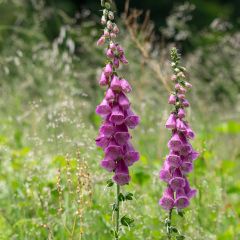
Digitalis purpurea - Common Foxglove
- Flowering time July to September
- Height at maturity 1,50 m

Digitalis purpurea Suttons Apricot - Foxglove
- Flowering time July, August
- Height at maturity 1 m

Digitalis purpurea Pams Choice - Foxglove
- Flowering time June to August
- Height at maturity 1,20 m
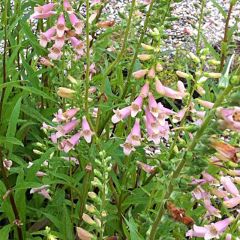
Digitalis Glory of Roundway - Foxglove
- Flowering time June to September
- Height at maturity 80 cm
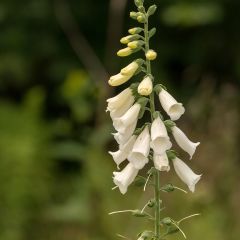
Digitalis purpurea Alba - Foxglove
- Flowering time June to August
- Height at maturity 1 m

Digitalis Goldcrest - Foxglove
- Flowering time August to November
- Height at maturity 50 cm
Some foxgloves differ from the most common varieties in their growing conditions. While the common foxglove prefers acidic soils, others can grow in lime-rich soil. They tolerate sunny positions, but avoid scorching sun, especially if you live in southern France.
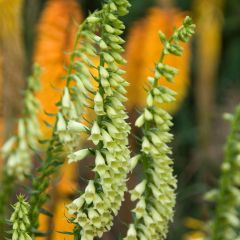
Digitalis lutea - Foxglove
- Flowering time July to September
- Height at maturity 80 cm

Digitalis parviflora - Foxglove
- Flowering time August, September
- Height at maturity 70 cm

Digitalis grandiflora - Foxglove
- Flowering time July to September
- Height at maturity 80 cm
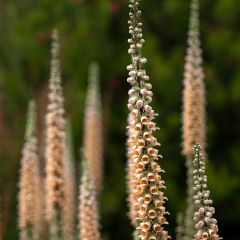
Digitalis ferruginea Gigantea - Foxglove
- Flowering time August, September
- Height at maturity 1,20 m
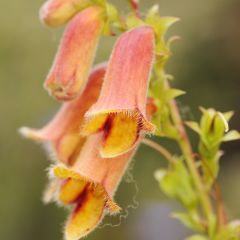
Digitalis obscura - Foxglove
- Flowering time July to October
- Height at maturity 60 cm
Digiplexis are less hardy but highly colourful varieties, resulting from a cross between foxgloves and their cousin Isoplexis canariensis.
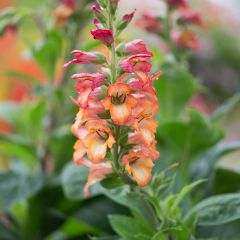
Digitalis valinii Illumination Flame - Foxglove
- Flowering time July to November
- Height at maturity 1 m
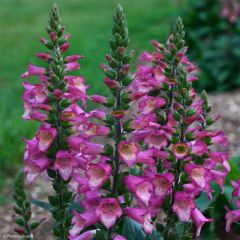
Digiplexis Berry Canary - Hybrid Foxglove
- Flowering time July to November
- Height at maturity 70 cm
Discover other Digitalis - Foxglove
Planting foxgloves
Where to plant foxgloves?
Foxgloves are known to be partial shade plants, thriving for example at the edge of woodlands. While they dislike scorching sun, foxgloves (especially cultivated varieties) can also grow in sunny spots. It all depends on your geographical location: in Mediterranean regions, it’s best to plant them where they’ll have shade during the hottest hours, whereas north of the Loire, they can be planted in full sun.
Foxgloves prefer light soils. Avoid heavy, clay soils that remain wet in winter, as these encourage disease. You can improve drainage by adding pumice, gravel or coarse sand at planting time. This helps water infiltrate more quickly. Foxgloves also appreciate organically rich soils, so adding compost when planting is recommended. A woodland-type soil would be ideal (loose, light, airy, humus-rich).
Foxgloves are quite tall plants: plant them towards the back of borders, behind shorter plants. They also work well planted just in front of hedges. Choose a sheltered position as wind can bend their stems, otherwise you’ll need to stake them. Select their position carefully – once established, foxgloves dislike being moved!
Common foxglove (Digitalis purpurea) prefers acidic soils. You can add some ericaceous compost at planting time. However, alkaline soils suit other species perfectly, such as Digitalis lutea, Digitalis parviflora or Digitalis laevigata…
While foxgloves generally prefer humus-rich soils that remain moist in summer, some species adapt well to drier conditions and thrive in rockeries or Mediterranean gardens. A good example is Digitalis obscura, a stunning foxglove with orange-red flowers.
When to plant?
Plant foxgloves preferably in autumn, ideally in October. Spring planting is also possible.
How to plant?
We recommend spacing them 30-40cm apart. Plant them in groups of at least three or five, avoiding solitary planting.
- Soak the rootball in a bucket of water to rehydrate it thoroughly
- Dig a planting hole. Loosen the base and incorporate some compost to enrich the soil. For heavy soils, add gravel or pumice to improve drainage.
- Place the rootball in the hole.
- Backfill with soil mixed with a few handfuls of compost, then firm down.
- Water generously.
Continue watering regularly until the plant is established.
Maintenance
Foxgloves are easy-to-grow plants that require little maintenance. They thrive in moist soil; avoid letting it dry out completely during summer by watering a little during heatwaves. Water directly at the base to avoid wetting the foliage, which could encourage diseases like powdery mildew or downy mildew.
Once established, avoid moving foxgloves to prevent damaging their rather fragile taproot. They may need staking, as their tall flower spikes are susceptible to wind damage. You can also apply a layer of mulch (wood chips, dead leaves, etc.) around the base to suppress weeds and keep the soil cool in summer.
We recommend cutting back the flower spikes once they fade, as this encourages new blooms and prevents the plant from wasting energy. However, you can also allow them to self-seed naturally by leaving a few spent flowers on the plant.
Foxgloves prefer rich, fertile soil: they will benefit from a layer of well-rotted compost in spring. Spread it around the base and lightly work it into the soil with a rake.
Foxgloves are generally resistant to diseases. However, they may occasionally suffer from powdery mildew or downy mildew. Powdery mildew appears as a white coating on the leaves and can be treated with a baking soda spray. They may also develop anthracnose, which causes brown spots on the foliage. Slugs and snails are fond of young shoots. Protect your foxgloves by spreading wood chips or ash around the base as a barrier, or make a slug trap.
Propagation: Sowing Foxgloves
Foxgloves are easily propagated by sowing their seeds. However, sowing horticultural varieties tends to produce plants that revert to their original form. They may not remain true to the variety you wish to propagate, particularly in terms of flower colour. To obtain young plants identical to the parent plant, it’s better to sow botanical species (Digitalis purpurea, D. grandiflora, D. lanata, etc.).
Sowing
If conditions are favourable and you haven’t removed the faded flowers, foxgloves will self-seed abundantly. You can leave a few spent flowers on the stems or collect the seed capsules and crumble them where you want new plants to grow. Don’t hesitate to harvest the seeds to sow them yourself. You can also buy foxglove seeds to ensure you get a true-to-type variety.
Foxglove seeds are easy to grow. You can sow them under cover or directly in the ground. Since they generally flower only in their second year and sometimes die after flowering, we recommend sowing them regularly (or, even simpler, letting them self-seed in the garden) to enjoy their blooms every year.
Under cover:
Sow the seeds in spring, around May or June.
- Fill a pot or tray with substrate (potting compost mixed with coarse sand for drainage and optionally a little ericaceous compost for acidity). Level and lightly firm the surface.
- Scatter the seeds over the substrate. Press them in very lightly but do not cover them, as they need good light to germinate.
- Water gently with a fine spray.
Place your sowing in a bright spot, at a temperature of around 18–20°C. Keep the substrate slightly moist until germination. Transplant the seedlings into individual pots when they reach 6–8 cm tall. Take care, as their roots are fragile, making transplanting tricky. You can plant them out in the garden in autumn, around October.
Direct sowing:
You can sow directly outdoors from May onwards and throughout summer.
- Prepare the soil by creating a fine seedbed (remove weeds, clumps of soil, and large stones). If your soil is chalky, add ericaceous compost. You can also mix in some potting compost.
- Sow the seeds on the surface.
- Cover with a very thin layer of substrate.
- Water gently with a fine spray.
Continue watering in the weeks after sowing. Many seeds will germinate, so thin them out to keep only the strongest seedlings.
Pairing Foxgloves in the Garden
With its tall, sturdy and upright stems, foxglove is a highly structural plant. It instantly adds volume and verticality to a somewhat flat flower bed. Take advantage of this by inserting its tall floral spikes among lower-growing plants like geraniums, heucheras, bergenias or lady’s mantle… Generally speaking, foxgloves are best planted at the back of borders, with shorter plants in front of them. With their slender, elegant spikes, they can create beautiful contrasts in form and break up the monotony of a flatter planting scheme.
Foxglove has a very wild, natural look, making it an easy fit for gardens with a naturalistic style. You can plant it among ornamental grasses and flowers like alliums, masterworts, columbines, knautias or geums… Preferably choose fairly simple, understated, delicate blooms. And, most importantly, allow foxgloves to self-seed freely, returning each year, sometimes in a different spot. For an effortlessly natural effect, don’t hesitate to plant foxgloves in woodland settings! Create a cool, wild garden by pairing them with ferns, toad lilies, hostas or Siberian bugloss… and perhaps shade-loving hydrangeas like Hydrangea serrata. The zesty hue of purple foxglove pairs perfectly with the soft green of ferns—not to mention both are striking plants that bring freshness. Since foxgloves naturally grow at woodland edges, you can also plant them against a country hedge to mimic a forest fringe effect.
Foxglove is an elegant plant offering a palette of delicate colours. Its blooms have a refined charm, with intricate patterns adorning the corolla’s interior. Use it to create a romantic atmosphere. Opt for pastel-toned varieties: pink, soft yellow, white, apricot (for example, ‘Sutton’s Apricot’), etc. Pair them with roses, masterworts, baby’s breath, hardy geraniums, and Oriental poppies!… In a similarly romantic, poetic vein, you can incorporate foxgloves into a cottage garden. Favour blue and white tones, lush foliage, and let a few upright spikes rise above the rest—foxgloves, of course, but also alliums or Culver’s root… Complement them with the graceful white umbels of Apiaceae, like Orlaya grandiflora. Foxgloves also pair beautifully with the delicate blooms of bellflowers (e.g., Campanula trachelium).
Some foxgloves, particularly Mediterranean species, can be integrated into dry or gravel gardens. This includes Digitalis obscura, which bears stunning orange-red flowers and thrives in heat and drought. Plant it in a south-facing garden with free-draining, stony soil, alongside rockery plants: yarrows, Stipa tenuifolia, cotton lavenders, houseleeks…
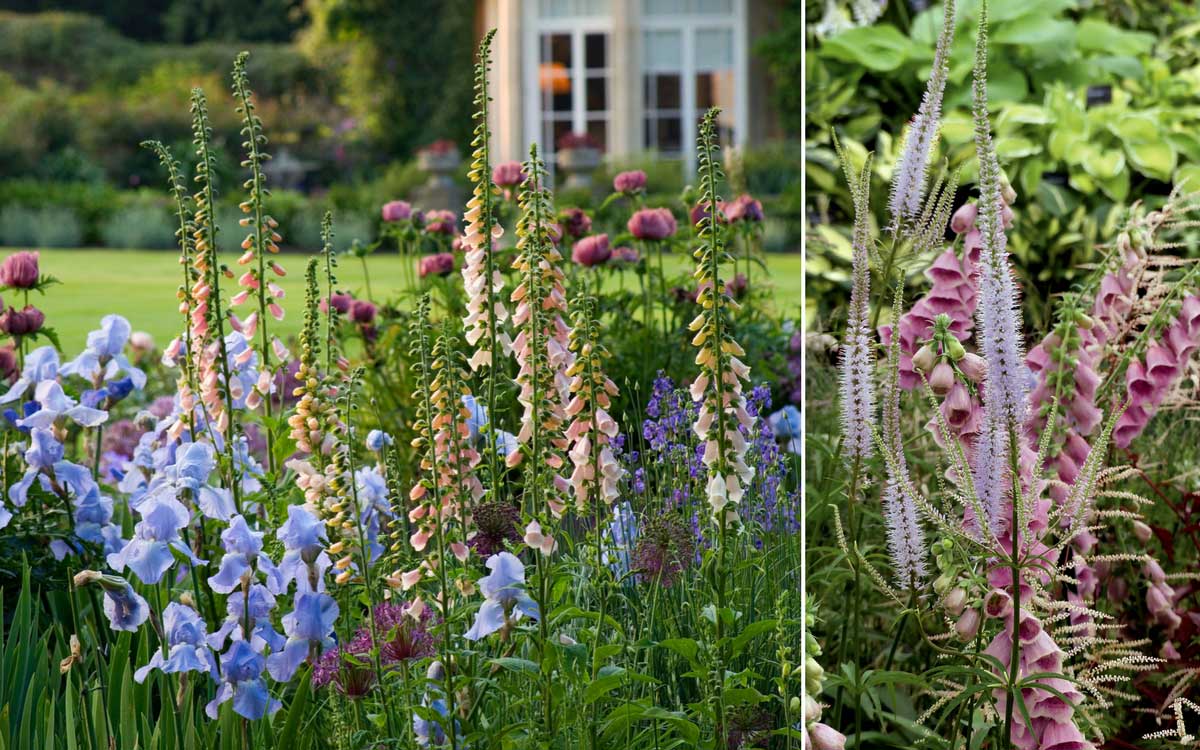

A planting combination with Digitalis ‘Suttons Apricot’, Iris ‘Jane Phillips’ and Papaver orientale ‘Patty’s Plum’ (photo Clive Nichols – MAP) / Digitalis mertonensis, Veronicastrum and Aruncus aethusifolius ‘Horatio’
→ Explore more foxglove pairing ideas in Christine’s advice guide
Useful resources
- Discover our range of Foxgloves!
- An article by Virginie on our blog – My Favourite Perennial Foxgloves
- Our advice sheet: Choosing a Foxglove
Frequently asked questions
-
The foliage of my foxglove is covered with a white, felt-like coating. What should I do?
Your plant is affected by powdery mildew, a fungal disease. You can cut off the affected parts, and when watering the plant, avoid wetting the foliage, instead direct the water flow towards the soil. Treat by spraying with a solution containing sulphur or baking soda.
-
I've heard that foxglove is toxic. Is this true?
Yes, it contains several cardiotonic substances (heart stimulants) in its tissues, including digitalis. Its powerful effect on the heart means it is sometimes used in medicines, but in its natural form, foxglove is toxic. However, it would never occur to us to eat it... We're content simply to admire it!
Similarly, it's always best to wash your hands after handling the plant.
- Subscribe!
- Contents


































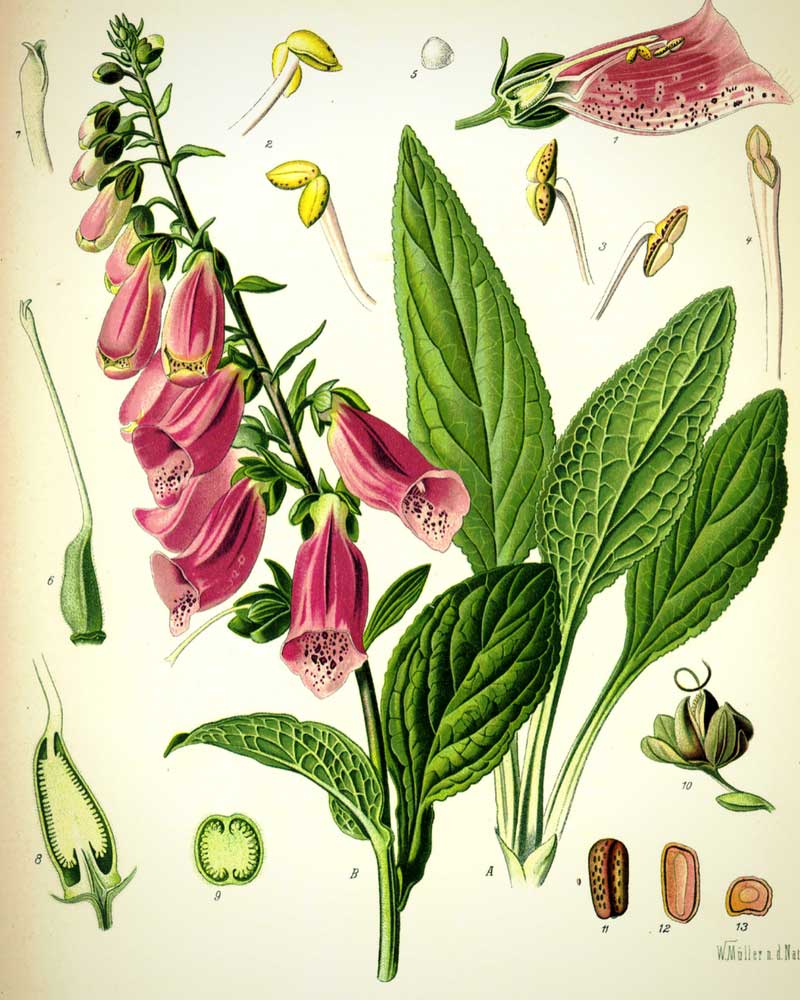








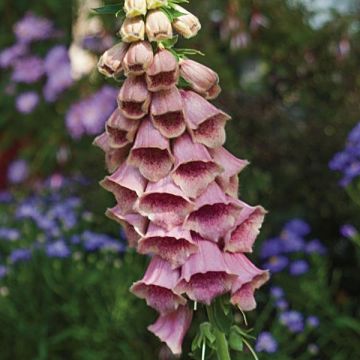
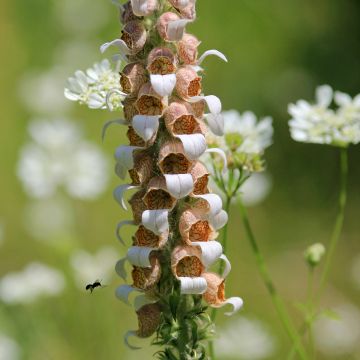




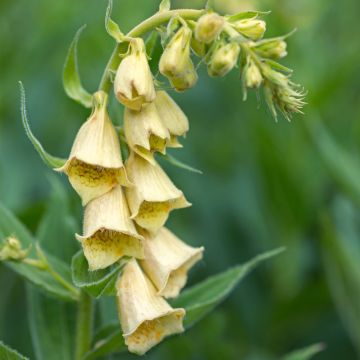
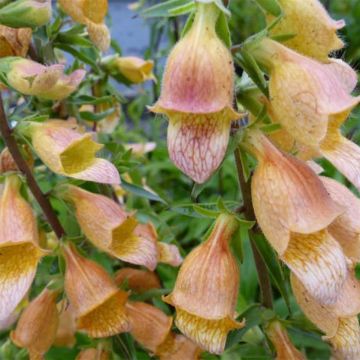

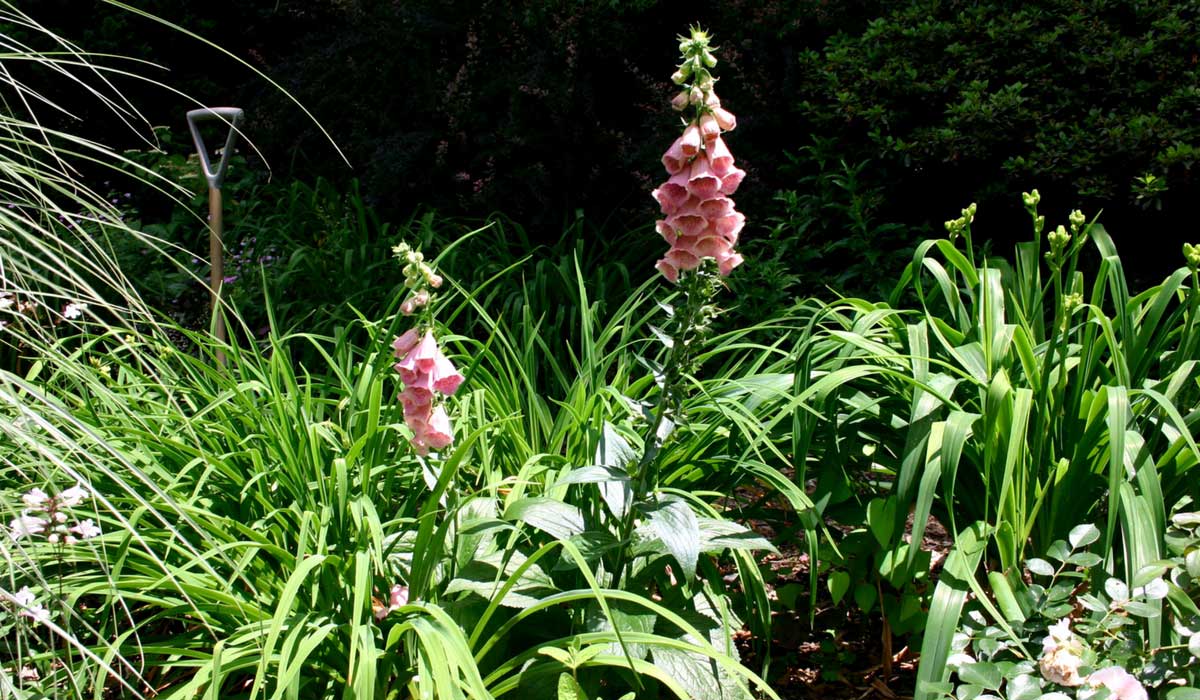
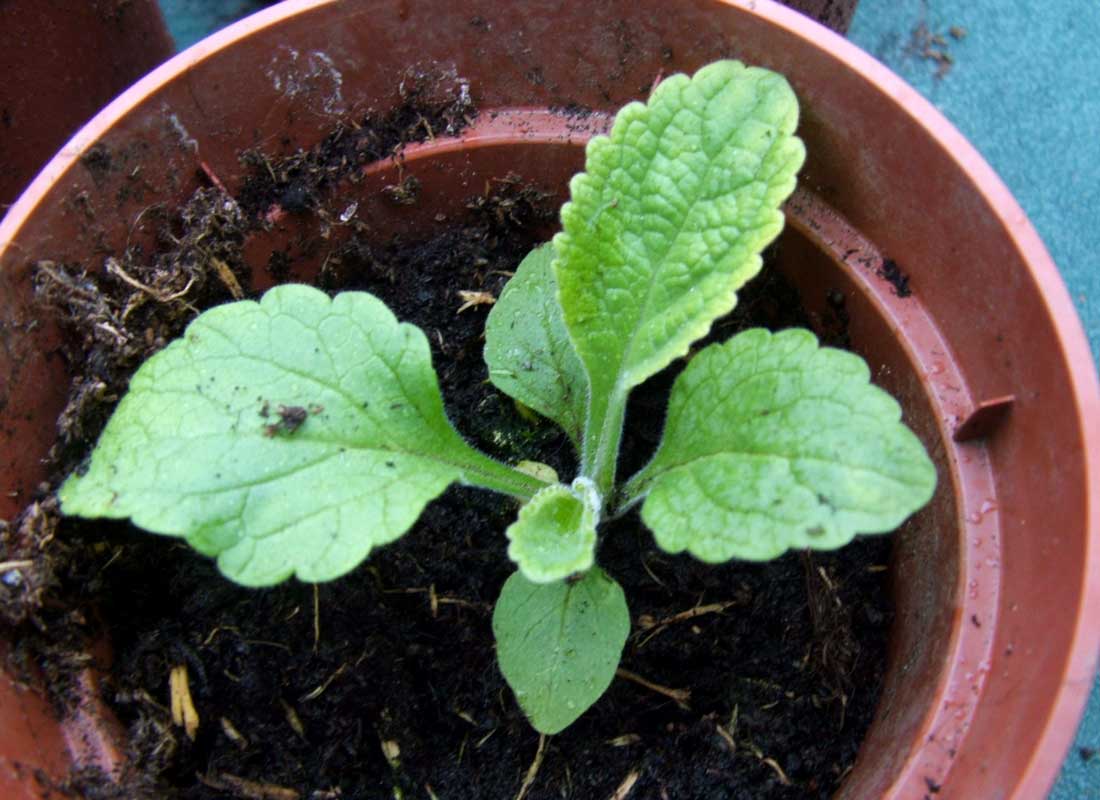
Comments